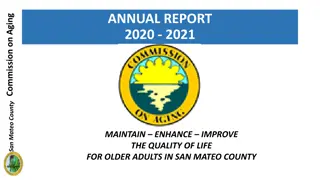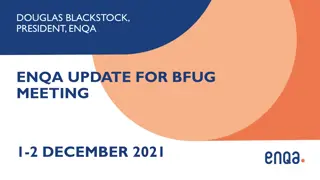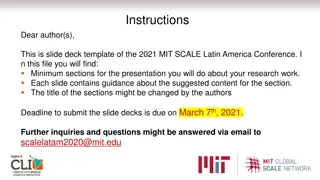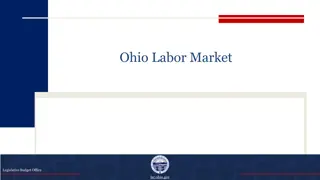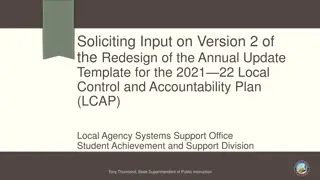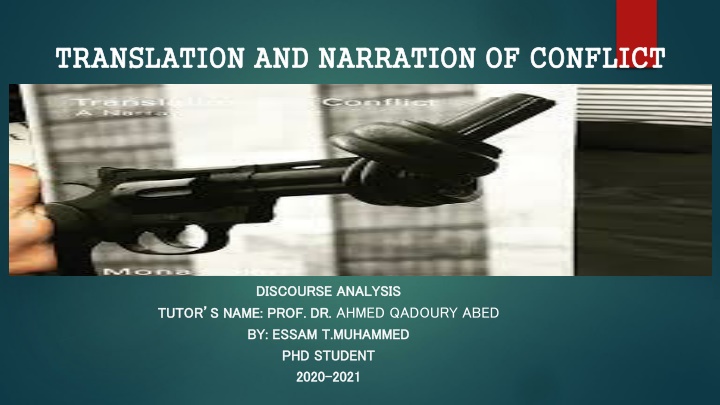
Narrative Approach in Conflict Discourse Analysis
Explore the role of narrative in conflict discourse analysis, delving into the influence narratives have on human behavior, beliefs, and societal structures. Understand how translation plays a vital role in legitimizing conflicting parties' narratives and shaping perceptions in a conflictive environment.
Download Presentation

Please find below an Image/Link to download the presentation.
The content on the website is provided AS IS for your information and personal use only. It may not be sold, licensed, or shared on other websites without obtaining consent from the author. If you encounter any issues during the download, it is possible that the publisher has removed the file from their server.
You are allowed to download the files provided on this website for personal or commercial use, subject to the condition that they are used lawfully. All files are the property of their respective owners.
The content on the website is provided AS IS for your information and personal use only. It may not be sold, licensed, or shared on other websites without obtaining consent from the author.
E N D
Presentation Transcript
TRANSLATION AND NARRATION OF CONFLICT TRANSLATION AND NARRATION OF CONFLICT DISCOURSE ANALYSIS DISCOURSE ANALYSIS TUTOR S NAME: PROF. DR. TUTOR S NAME: PROF. DR. AHMED QADOURY ABED BY: ESSAM T.MUHAMMED BY: ESSAM T.MUHAMMED PHD STUDENT PHD STUDENT 2020 2020- -2021 2021
Outline Introduction Narrative Approach Narrative Typology Model Narrative, Discourse, and Myth Features of Narrativity Is Narrative a Separate Genre or Not? Framing Narrative in Translation Narratively &Normalizing Narrative and Truth
The Notion of Constructedness Historical Intertextual Narratives Narratives Cross Linguistic Borders A Narrative Typology Model Features of Narrativity Framing Narratives in Translation Conclusion References
Introduction Alongside ideology and media, conflict constitutes the third side of this triangle of political discourse-related concepts. Whatever roles people occupy in life and whatever activities they participate in, they remain part of a conflictive environment. They contribute to shaping this environment while it influences them accordingly. Today s conflicts not only influence the geographical area in which the conflict occurs, they also transcend political and social boarders, exerting an instant impact on a larger regional or even global population. Therefore, translation, whose main function is to facilitate communication across linguistic boundaries, becomes substantially sought after by opponents and disputing parties to legitimise and promote their descriptions of the conflict while undermining the rival parties narratives .
A Narrative Approach Defining the concept of narrative Defining the concept of narrative Labov (1972: 359-60) defines narrative as a way to summarize personal experience by using linguistic and verbal utterances, i.e. words and sentences, to describe events that indeed took place . Fisher (1987: 193) suggests that through narration, all forms of communication are interpreted, assessed, and judged. Unlike discourse production which expresses a deliberate decision made by the producer, narration, for Fisher (ibid), it is an act that reflects the background knowledge and experience of the narrator . According to Baker (2006: 19), narratives can be the stories that people narrate to themselves, as well as to others. They may touch people s personal lives or tackle public issues, ultimately governing people s actions and influencing their beliefs .
Bennet and Edelman(1985: 159) affirm that narratives can significantly influence human behavior, way of thinking, morals, values, principles, and the way people perceive themselves and the surrounding world For Bruner( 1991: 5-6)The significance of narratives does not lie in the way they are structured but rather the way they function as tools for changing attitudes and constructing reality . Baker (2006: 3) points out that narratives refer to stories that are produced and circulated, often by ordinary people on a daily basis, and thus develop dynamically and change subtly or radically when narrators encounter new experiences and hear fresh stories . Whitebrook (2001: 15) affirms that narratives allow the representation of personal identities with singular sets of characteristics that may not be consistent with any proposed political affiliations or groupidentity .
Narrative, Discourse, and Myth Baker draws a comparison between the three concepts of narrative, discourse, and myth. Narratives :Concrete&Accessable They feature personal stories produced by normal individuals. They are not limited to stories serving public interests and causes Discourse : Much more abstract . Myth : It constitutes an element in a second-order semiological system,
Features of Narrative Theory Features of Narrative Theory Baker (2006: 3) points out three main features of narrative theory. 1.Narrative theory suggests that people s actions are steered and influenced by the stories they hear about, and conceive from the outside world making them forming their judgements accordingly . 2.Narrative theory emphasizes the dynamicity of narratives and their ability to change and constantly evolve. Therefore, people do not just choose the stories they circulate, yet they contribute to forming and developing stories . 3.Due to their tendency to change as following new exposures and experiences, narrative theory claims that narratives have a subversive nature. Narratives can be transformed and even reversed, and thus evolve into counter-narratives whose ultimate function is to challenge and undermine the original ones .
Is Narrative a Separate Genre or Not? Is Narrative a Separate Genre or Not? Baker (2006: 9) does not consider narrative as a separate genre since a narrative is not confined to political and social topics. Instead, it can refer to technical and scientific texts, as there is no text that does not benefit from, or constitute a part of, the story of life (Fisher, 1987: 85). Even a scientific paper leading to findings and conclusions represents an organizedsequence of events that follows the regular pattern of a typical narrative, which includes a beginning, a middle, and an end (Landau, 1997: 104). Predictably, statistical figures are often employed to contribute to conflict between competing narratives by supporting one while undermining the other. . Example: In the context of the Arab Spring, Middle East Monitor reports on the use of allegedly fake statistical figures to support the legitimacy of the Egyptian opposition s demands and the reportedly pre- planned military coup following large-scale anti-Morsi demonstrations on June 30, 2013
[T]he numbers game was played by the opposition and the military to orchestrate and justify the coup d etat against President Mohamed Morsi. For whatever reason, several external parties also used the numbers claimed to validate their support for the military intervention To give their statistics an air of respectability and credence, the anti-Morsi alliance claimed that their crowd statistics were obtained from coverage and analyses conducted by Google Earth. Though never confirmed by the satellite giant, the estimates given ranged from 14.3 million to 33 million demonstrators. A search of the net revealed no official statement by Google Earth to confirm these claims. Meanwhile, MEMO requested a comment from Google but has not received a reply . (Middle East Monitor, July 2013)
Narratively &Normalizing Narrativity is often employed in political contexts to exert a long-term normalizing effect on listeners (Baker, 2006: 11) in order to accept and believe the stories they hear about events without questioning or expressing any doubts with regards to the credibility and trustworthiness of the source. The Arab Spring has proved that narratives can be used by autocratic regimes as a propaganda weapon to justify brutal procedures against opponents, civil and political activists, and demonstrators.
The Houla Massacre took place in the Syrian village of Taldou, located in the Houla Region near Homs on May 25, 2012, and was reportedly carried out by pro-Assad militants. The National Review Online news outlet published an article by Aymenn Jawad al-Tamimi and Phillip Smyth, investigating the narrative that the Assad regime constructed, attempting not only to deny their responsibility for the massacre, but also to portray its loyalists to be the victims. The authors attempted to observe the reports undertaken by various newspapers on the event and Assad s propaganda in general: FAZ [German newspaper Frankfurt Allgemeine Zeitung] alleges that not only did opposition-group members carry out the Houla massacre, but the victims were principally Alawites that is, part of Assad s religious sect along with some Sunni families that had converted to Shiism (Tamimi and Smyth, 2012)
Translation as a mandatory medium of communication is essential in normalizing and nourishing narratives across linguistic barriers (Baker, 2006: 14). Any conflict, whether political, military, or social, is necessarily a conflict of image in which all parties aim to construct and deconstruct an enemy by delegitimizing its actions and distorting its image. Nelson (2002: 8) asserts that a conflict entails dehumanizing the enemy and dealing with the enemy as a foreign and distant entity. This subsequently provides a pretext for torturing, maiming, and slaughtering the other. Translators and interpreters contribute to either facilitating or challenging this process of dehumanization, which aims to transform the who into it whose misery and anguish become acceptable and tolerable (Baker, 2008: 14) .
Narrative and Truth The receiver s endeavor to reason on a certain narrative is ultimately governed by the believability of the narrative, which is determined by whether the story is derived from, and backed by, some facts and thus linked in some way to reality. This, according to Baker (ibid: 17-8), brings in the whole question of the relationship between narrative and truth. Zhang (2004: 400) advises not to take any historical event as an absolute and unquestionable truth. This is not a call for skepticism; he encourages us to study history, take the claims made by historians and subject these claims to careful examination and analysis. Only by doing so can people avoid falling into the trap of blindly believing in narratives that affect people s perception of the world. .
The Notion of Constructedness The notion of constructedness thus can be summarised by four main pieces of advice for those seeking the truth: 1.take claims embedded in narratives. 2.validate their credibility. 3.Do not entirely reject the truthfulness of a certain narrative. 4.Acknowledge the existence of multiple truths since knowledge is socially and politically produced (Ewick and Silbey, 1995: 199).
Historical Intertextual Narratives conflict between competing narratives is not confined to a certain period of time; rather it continues over time (Baker, 2006: 20). The Syrian revolution and Iraqi conflict have shown how narratives of the past can define present narratives; former Iraqi prime minister Nouri alMaliki interpreted his political conflict with his opponents took place hundreds of years ago between Husayn and Yazid (al-Maliki, Dec 2003): in light of historical events that [ Supporters of Yazid and supporters of Husayn, once again as always are engaged in a fierce and bitter confrontation, and this proves to us that the crime that Husayn was the victim of has still not ended . Al-Maliki s statement shows how a narrative on an ancient conflict between two figures in Islamic history is repacked after more than thirteen centuries, continuing to affect, explain, and shape present narratives which depict a completely different conflict .
Narratives Cross Linguistic Borders Translation is essential in this process, since most conflicts are not limited to communities that speak the same language. Rather, they cross linguistic borders and reach out to communities that speak different languages. In most cases, they are discussed in multi-lingual regional and/or international environments, such as the Security Council where competing narratives use translation as a weapon of persuasion as well as a method of communication (Baker, 2006: 22). When a narrative is translated and re-told in a different language, it embraces new elements from other narratives floating in the new cultural and linguistic atmosphere. It thus develops into a new narrative modified by the new narrators. This constantly evolving narrative, in turn, influences and contributes to shaping other narratives that circulate within news linguistic communities (ibid) .
A Narrative Typology Model This study will adopt a typology model primarily suggested by Somers (1992, 1997) and Somers and Gibson (1994), and thereafter developed by Baker (2006). Based on their social effect and political significance, this model makes a clear distinction between four main types of narrative: 1.Ontological 2.Public 3.Conceptual 4.Meta-narratives
Ontological Narratives Baker (2006: 28) defines ontological narratives as personal stories that we tell ourselves about our place in the world and our own personal history. These stories shape and give the people s lives their meanings. Even though they essentially tackle issues related to the self in the first place, they are also interpersonal and social since they are communicated to other people in a social environment (ibid). The existence of a social context is vital for the narrator to tell their story allowing it to exist, function and develop (Whitebrook, 2001: 24) .
INTERRELATIONSHIP BETWEEN ONTOLOGICAL &COLLECTIVE NARRATIVES 1.ontological narratives are contingent on and determined by the collective narratives that circulate in the surrounding social environment . 2.Ontological narratives are important in maintaining and elaborating collective narratives. 3.Collective narratives therefore contribute to the forming as well as framing of personal stories produced by members of a given society, setting their meanings, implications, and effects 4.The collectiveness of a narrative, one the other hand, cannot be achieved until supported and enhanced by many personal stories. Only then, can such a narrative be seen as collective and thus be accepted, widely circulated, and normalized into self-evident accounts of life in order to avoid critical examination .
The following is an excerpt from a report including a field interview undertaken by Orient News reporter with a Syrian boy from Aleppo after a rocket reportedly fired by Assad s troops hit his family house and killed many of his relatives in 2013 (Orient News, 2013): !.. . ... . . . . ... These personal narratives about personal experiences in fact contributed to a collective antiregime narrative adopted by the Syrian opposition and the Free Syrian Army, allowing it to gain currency and acceptance, not only internally but also internationally.
Public Narrative Public narrative which is similar, but not identical to the aforementioned collective (shared) narratives. They are best defined as stories produced and communicated at the level of communities and institutional bodies higher than an individual, such as the sect, school, university, political party, city, and country (ibid). Public narratives dominating a given community may quickly evolve, develop, and witness changes within a few years or even less (Baker, 2006: 33). An example of competing public narratives depicting the outbreak and mobilisers of the Arab Spring is a speech by Saif al-Islam, Gaddafi s son on February 20, 2011, in which he expressed the Libyan regime s version of the narrative about how the mass uprising started in the Eastern part of the country and the parties responsible for starting the movement (Saif al-Islam Gaddafi, Feb 2011):
... .. ... .. ... .. .. .. The Libyans had to either believe or reject Saif al-Islam s version of the public narrative of the outset of the February 17th Revolution. This is dependent on whether this narrative, in all its aspects, is compatible with every Libyan s own story of identity in fact, public differ in the way they define their identity socially, nationally, religiously, and politically, and thus varied. their stories of identity are
conceptual narratives Somers and Gibson (1994: 62-3) define conceptual narratives, the third type of narrative, as explanations and analyses that social researchers and scholars provide to demonstrate and illustrate the relationship between ontological and public narratives. . An example of conceptual narrative is the book, The Arab Spring: The End of Postcolonialism, by Hamid Dabashi. The Washington Post describes the book as a leading cultural observer of the Arab Spring events. It provides a conceptual and intellectual account of the Arab Spring and its implications, factors and impact. It sheds further light on personal narratives associated with the event, linking them to mainstream public narratives circulating among the revolutionaries and the Arab people in general about the Arab Spring revolutions. As in the case of public narratives, translators have the liberty to support and enhance or reject and refute a certain conceptual narrative (Baker, 2006: 43) .
metanarratives Somers and Gibson (1994: 61) provide a brief definition of the fourth type of narrative metanarratives as narratives in which we are embedded as contemporary actors in history. A Metanarrative is a narrative about narrative .A possible example of a meta-narrative in present times is the public narrative of the war on terror, which has been extended recently to include the war on Islamic State, which is aggressively sustained and promoted through a myriad of channels across the entire world, thus rapidly acquiring the status of a super-narrative that cuts across geographical and national boundaries and directly impacts the lives of every one of us, in every sector of society. . The military action would not have been possible if not preceded by circulation of a meta-narrative on the members. brutal and barbarous actions carried out by IS
Features of Narrativity Baker(2006) points out eight different features of narrativity; the first four are formerly proposed by Somers and Gibson (1994) and Somers (1992, 1997), while the rest are originally suggested by Bruner (1991): Temporality Relationality Causal Emplotment Selective Appropriation Particularity Genericness Normativeness/Canonicity and Breach Narrative accrual
Temporality Temporality is seen, according to Baker (2006: 50), as an essential feature that constitutes the narrative, rather than as an additional or separable layer of a story . It does not imply, as many may expect, that events are arranged in the right sequence to represent, and be consistent with, the actual chronological order of the story events in reality. Rather, it means that the order in which the story details are arranged is significant (ibid: 50-1) and cannot be changed or replaced without resulting in a loss of meaning. Therefore, temporality has an organizational function that is important for the audience to interpret and comprehend the narrative; events and characters included in the story are not considered as meaningful to the audience if they do not follow a sequential structure, both temporally and spatially (ibid: 51) .
Relationality Baker beings by nature cannot make sense of events that are not logically connected. In other words, for a text to be perceived as narrative, there must be a degree of coherence. Bruner (1991: 8) asserts that composing a narrative requires more than merely choosing random events derived either from present reality, the past, or fiction, and then arranging them in a suitable sequence story events need to be structured in line with the larger narrative. (ibid: 61) explains that is an important feature of narrativity, as human relationality Example: black man, which is consistent with the expectations of African believers. A similar tendency is observed in Western churches, in Europe and North America, where Jesus is pictured as a white blonde man. Most African churches draw a picture of Jesus in their divine narratives as a When translating a narrative from one language into another, the translator may avoid importing source cultural or religious elements that do not relate to, or are not consistent with, the target culture. Baker (ibid: 64) argues that translators in many cases decide are differently or negatively employed in other Baker (ibid), it is an aspect of maintaining relationality not to borrow an utterance or element from an alien narrative . not to opt for in equivalents target which For narrative contexts the culture.
Causal Emplotment According to Somers (1997: 82), causal emplotment gives significance to independent instances, and overrides their chronological or categorical order. In concrete terms, causal emplotment means that two people may agree on a set of facts or events but disagree strongly on how to interpret them in relation to each other. For instance, one narrative of the Middle East conflict depicts Israeli-targeted assassinations as a response to Palestinian terror attacks, while another narrative depicts Palestinian suicide bombing as a desperate and inevitable outcome of Israeli state terrorism. Proponents of the two competing narratives may accept that the individual events (or episodes) took place, and even agree on the details of each event (who did what, where and when), but disagree strongly on how the events relate to each other and what motivates the actors in each set of events
Selective Appropriation A narrative may seem complete and whole, yet it is in fact composed of a limited number of events to the exclusion of other events (White, 1987: 10). This exclusion and inclusion may be guided and influenced by factors related to certain ideologies, agendas, and cultural and political affiliations. A representation of this feature of selective appropriation in the field of translation is the tendency of translators and/or sponsoring media outlets to select certain materials (texts or videos) for translation. The selection process is undoubtedly governed by the patrons agendas and benefits as well as the translator s ideology . Example :Fox News and The Mirror often present a negative image of the opposition fighters, especially those fighting alongside Islamist factions.They tend to highlight some violations against locals in opposition-controlled areas, ignoring examples of efficient management, good treatment, and moderate ideology
particularity By particularity, Bruner (1991: 6 7) means that narratives refer to specific events and people but nevertheless do so within a more general framework of storytypes , which give the specific happenings their meaning and import.Broadly speaking, an individual narrative derived from a given storyline may vary in specifics (names, settings, nuances of character) but will ultimately be a variant of that skeletal storyline .
Genericness Classifying the story (narrative) as a kind of genre that frames meaning .These genres serve as established models that enable both narrative producers and audiences to limit the interpretative task. Bruner (1991: 14) adopts a different definition of genres as recognizable kinds of narrative such as tragedy, comedy, fiction, satire, news report, and interview. We recognize the cartoon as having comedic reference with a message of morality.
breaches of Canonicity For Bruner, breaches of canonical scripts are what makes a narrative worth telling, which implies that material that does not involve some form of innovation or breach does not constitute a narrative in his translator opts for equivalents that make the narrative intelligible for the target reader. This can also be done through a process of recontextualisation to form a narrative with moral resonances for the target audience (Baker, 2006: 99) . By observing normativeness, a view. Example: An old Palestinian man expresses his shock at what happened to his house Jenin camp in the Occupied West Bank . What can I say, by God, by God, our home is no longer a home What can I say? Not even Vietnam was as bad as this.
narrative Accrual Bruner (1991: 18) describes narrative accrual as the way in which people cobble stories together to make them into a whole of some sort. This can be accomplished by imposing bogus historical-causal entailment (ibid: 19). An example from the context of the Arab Spring is the proposition that the Arab Spring revolutions would not have taken off if the Tunisian revolution had not happened in the first place. The five revolutions, according to this view, are interlinked narratives that cannot be assessed and interpreted in isolation.
Framing Narratives in Translation Translation can be seen as an act of framing that can bring about changes in terms of the message as well as the style of the text translated. There are five aspects of framing suggested by Baker (2006),they are : frame ambiguity, temporal and spatial framing, selective appropriation, framing by labelling, and repositioning of participants . 1.Frame ambiguity, according to Baker (2006: 107), occurs when a sequence of events is framed differently to foster rival narratives produced by different parties, which are aimed at legitimising their actions in the context of a given conflict . ( ) ( , ) ( )
Frame ambiguity can also be employed in translation (Baker, 2006: 108), as translators at times decide to change the definitions of certain situations embedded in the source text, opting for choices in the target language that match certain ideologies in line with their political affiliations and/or the patrons interests and agendas 2.Temporal and spatial framing :Thiskinddenotes the process of choosing a specific text that depicts a certain narrative, placing it in a new temporal and spatial environment. Readers and listeners are encouraged to make a connection between this narrative and others that may be more upto-date even though its events actually belong to different temporal settings or take place in a different geographical area . & 1.Not expecting it to happen that soon 2.Both parties not well prepared 3.Both won . In an interview with Dr. Ragheb Elsergany, a Muslim cleric and historiographer
3.Selective appropriation, the third aspect of framing suggested by Baker (2006), is manifested through omitting and/or adding some elements of a narrative when it is told to a different audience or when rendered into a foreign language (ibid: 114). The omission and addition procedures aim to suppress, accentuate or elaborate particular aspects of the narrative encoded in the source text or utterance, or aspects of the larger narrative(s) in which it is (ibid). embedded This form of framing can sometimes result in a diversion of the message embedded in the source version of the narrative to make it consistent with certain ideologies and agendas . A representative example of this aspect of framing is the satirical news analysis show DNA, presented by Lebanese journalist and political analyst Nadim Koteich aired on Future TV on a daily basis (Future TV Nadim Koteich, 2013). Koteich analyses and comments on the latest political events in Lebanon, Syria and the Arab World using selected elements of statements and stories produced by politicians and political commentators. These excerpts, which are often subjected to numerous omission procedures, are exploited to criticise the same narratives that these excerpts are derived from. The narratives criticised by Koteich are typically promoted by political opponents, namely Hezbollah, Iran, and the Syrian regime .
4.Framing by labelling : It is described by Baker (2006: 122) as any discursive process that involves using a lexical item, term or phrase to identify a person, place, group, event or any other key elements in a narrative. . Consider the following examples of these forms of framing and the controversy over them; , , , , , , ,
5.Repositioning of participants the way in which participants in any interaction are positioned, or position themselves, in relation to each other and to those outside the immediate event (ibid: 132). Any changes to these positions redefine the roles played by the participants and their interrelationships as well as the dynamics of the narrative as a whole and even . other interlinked narratives Repositioning of participants aspointed out by Baker (ibid) can occur through the way language is utilised to manage time, space, register, tone, and other manners of identifying them and us. Subtle, paratextual, and/or expressive changes made by the narrator or translator in the representation of these elements are cumulated, relationships between participants, such as leading narrator, to translator, a reconfiguration hearer, of the the and reader.
Conclusion Narrativity and framing play a crucial role, not only in constructing reality, but also in shaping national, social and political identity. Personal, public and master narratives have proved to be an integral part of political conflict; they are exploited as accounts depicting happenings (typically in line with the agendas and ideology of the narrator) and to legitimise the actions of the self and delegitimise all what the other represents (values, beliefs, actions, decisions, etc.). Translation has always been part of this process; narratives need translation in order to circulate beyond national, cultural, and linguistic boundaries, and be effective in both constructing reality and defending the self against the other in political and social conflict.
References . Bruner, Jerome (1991) The Narrative Construction of Reality , Critical Inquiry 18(1): 1 21. Fisher, Walter R. (1987) Human Communication as Narration: Toward a Philosophy of Reason, Value, and Action, Columbia: University of South Carolina Press. Hinchman, Lewis P. and Sandra K. Hinchman (1997a) Introduction , in Lewis P. Hinchman and Sandra K. Hinchman (eds) Memory, Identity, Community: The Idea of Narrative in the Human Sciences, Albany: State University of New York Press, xiii xxxii. Nelson, Daniel (2002) Language, Identity and War , Journal of Language and Politics 1(1): 3 22. Somers, Margaret (1992) Narrativity, Narrative Identity, and Social Action: Rethinking English Working-Class Formation , Social Science History 16(4): 591 630 Zhang, Longxi (2004) History and Fictionality: Insights and Limitations of a Literary Perspective , Rethinking History 8(3): 387 402





